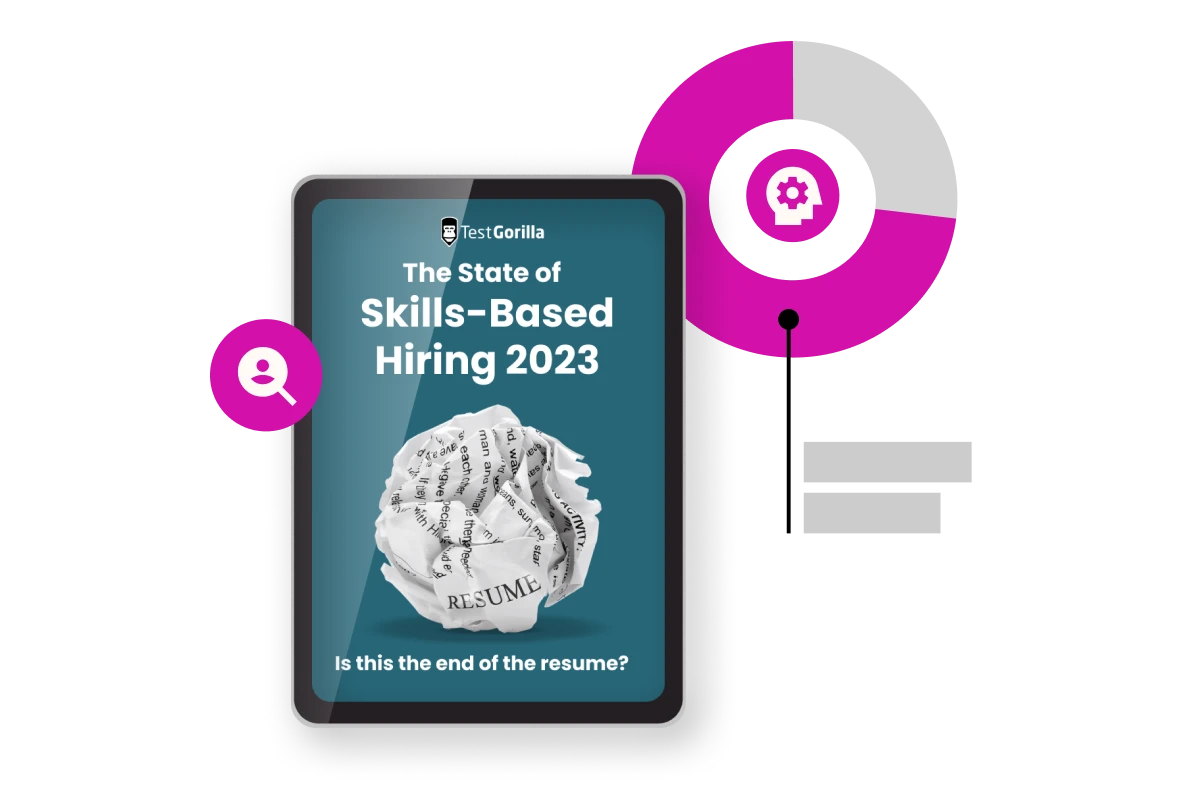Alice Keeling
Alice is a staff writer at TestGorilla. She has a Master's degree in modern literature and has been writing about skills-based hiring for over 2 years, authoring thought leadership content, annual reports, news, and campaigns. She researches and writes about the intersection of hiring, social justice, and DE&I.
Read articles written by this author
Skills-based hiring is on the rise. What does this mean for recruitment?
In case you didn't know yet, skills-based hiring is on the rise. In this article, we’ll use data we collected from 3,000 employers and employees to discuss the rise of skills-based hiring, describe what it means for recruitment, and explain how a skills-based approach can help you make the most of your hiring budget.
How skills-based hiring helps STARs tear down the paper ceiling
We know how this headline sounds, but no, this blog post isn’t about helping Dua Lipa start a new career as a warehouse supervisor. The term “STAR” actually stands for “Skilled Through Alternative Routes” and refers to workers who have gained valuable skills outside the now-expected path of a college education. STARs make up 50% of the American workforce, and yet the traditional hiring techniques used by many employers – including resume review and degree requirements – exclude them from roles where they can demonstrate their value.[1] In this blog, we show how opening your recruiting process to STARs with skills-based hiring not only improves their careers, but helps you create more diverse, innovative, and not to mention happier teams. Most importantly, we discuss how skills-based hiring can help tear the paper ceiling.
10 inspiring skills-based recruitment stories
We’ve been carefully building a team since TestGorilla launched over two years ago, and today we hired our 100th team member. We practice what we preach, so every one of our people has been recruited for their skills, using our product. And based on their experiences, we know that skills-based hiring has the power to change lives. In order to share some of that power, we asked 10 team members to talk about their careers before TestGorilla, and their experiences with both CV-based and skills-based hiring. Read on to discover 10 stories that demonstrate why companies need to adopt skills-based hiring.
How skills-based hiring can build a culture of belonging
When employees feel like they belong at work and are an integral part of a close-knit team, the results are far-reaching: Their job performance increases by 56%, their turnover reduces by 50%, and they take 75% fewer sick days.[1] Belonging is also cited as a leading driver of employee engagement, and 91% of employees who feel they belong are engaged at work as opposed to 20% of those who don’t.[2] However, creating a culture of belonging at work involves more than offering a friendly welcome to new team members. It’s about building a diverse team and ensuring that everyone is treated equally and feels included. Objective and data-backed recruitment practices like skills-based hiring help you do that by helping you hire for skills and ability, not subjective factors like background, union membership, or connections to existing staff. In this article, we’ll examine how skills-based hiring helps companies increase diversity and improve employee happiness and retention. We’ll also look at how to use a skills-based approach to identify and develop the soft skills necessary for creating an inclusive and welcoming work culture, as well as provide practical tips for building a culture of belonging.
4 reasons employers hire faster with skills-based hiring
It's safe to say that traditional hiring methods aren't saving time for anyone. Job seekers spend hours tweaking resumes, whilst recruiters spend their days sifting through them without gathering any relevant information about what a candidate’s actual skills are. Skills-based hiring, however, cuts right to the chase. Assessing and hiring for a candidate’s skills by using multi-measure assessments is a proven way to hire faster – in fact, 82% of employers using skills-based hiring told us it reduced their time-to-hire. Read on to find out how to hire faster with skills-based hiring.
Skills-based hiring around the world: Who’s leading the charge?
If you aren’t doing it yet, that’s ok: 58% of companies we surveyed only just adopted skills-based hiring in the past two years. But from the United States to Singapore, a skills-based approach is quickly becoming a popular way for recruiters to attract and retain global talent. The reasons for using skills-based hiring vary from region to region. In some parts of the world, organizations use it to streamline high-volume hiring. While in others, the focus is on making teams more diverse and equitable. Let’s take a closer look at how skills-based hiring works in the USA, UK, and the Asia-Pacific region. We’ll compare the reasons for implementing the practice—and the results of doing so. We’ll also highlight what these examples can teach us about creating a more diverse and higher-performing workforce.
How to take a skills-based approach to blue-collar recruitment
Employers are finding it increasingly difficult to fill their blue-collar job openings. The Covid-19 pandemic and the Great Resignation have contributed to this hiring shortage, but attracting and retaining skilled blue-collar workers was an issue even previously. With older workers retiring and many younger workers opting for four-year degrees or white-collar work, companies need to adjust their blue-collar recruitment strategies.[1] Skills-based hiring locates talented workers by focusing on skills instead of education and prior job experience. Using skills assessments and structured interviews, and investing in upskilling and employee development, are all ways to take a skills-based approach to blue-collar recruitment. This article contains everything you need to know about taking a skills-based approach to blue-collar recruitment.
How to recruit for white-collar jobs using skills-based hiring
White-collar jobs can be really difficult to hire for because the roles and responsibilities of white-collar workers are often a blend of high-level hard and soft skills and experience. This makes tasks and roles can be hard to define. Traditional hiring practices seem to ignore this crucial question by gathering the fluid work responsibilities of white-collar jobs into singular job titles and organizational hierarchies. In other words, they use blue-collar hiring practices for white-collar jobs. With rapid ongoing changes in technology, consumer behaviors, and employee demands, this overly simplistic view of white-collar work compromises organizational agility, growth, innovation, diversity, and a positive employee experience.[1] On the other hand, adopting skills-based hiring practices and working models caters to the fluid responsibilities and requirements of white-collar work by centering skills over degrees, resumes, and cover letters during the hiring process. Let’s take a look at the skills necessary for such jobs before diving into six examples of white-collar jobs and how to hire for them.
Hiring for startups: Should you hire for a short-term fit or the potential to scale?
When you’re launching a startup, building the right team is everything: 14% of startups fail due to not having the right people on board.[1] And yet, it’s fraught with complications. Let’s say you’ve identified social media as a key engine for your brand’s growth in the next six months. You know you need a dedicated team member to craft your strategy and manage your channels, but when it comes to hiring, you find yourself in a bind. One of your candidates is highly skilled in social media management and would undoubtedly maximize the effectiveness of your social media push in the short term – but their long-term career goals don’t align with your vision for the role. Your other candidate isn’t as experienced, so their effectiveness in the short term might be less impressive. However, they’re keen to progress with your company, and they have a broad range of additional marketing skills that could inform your other initiatives. Who do you prioritize: the candidate who provides the best short-term fit, or the one with the most potential to scale with you? This dilemma is one of the most challenging parts of HR for startups, and we’re here to help you navigate it. In this blog, we take you through the benefits and drawbacks of hiring for short-term fit vs. the potential to scale, when it’s appropriate to use each strategy, and the best practices for doing so.
7 challenges employers face when adopting skills-based hiring (and how to overcome them)
A switch to skills-based hiring brings major incentives. Our own research shows that not only is it the norm, with almost 81% of businesses already using it, but of those businesses: 78% saw a reduction in cost-to-hire 81% saw a reduction in time-to-hire 90% saw an increase in diversity However, like any transformation, it can’t happen overnight. To get these big results, you first have to make big changes. You can’t simply swap resumes for personality tests and find motivated candidates right away. In this post, we discuss the barriers that are standing between you and skills-based hiring. These include the roadblocks to prepare for, the systems you need to put in place, and the proper approach to get buy-in from senior executives. First, we need to talk about where resistance to skills-based hiring comes from.
Skills-based compensation: A fairer way to pay
In a bid to compete in the war for talent, more companies are removing degree requirements from job descriptions, adopting skills-based hiring, and implementing pay transparency measures. According to our 2022 State of Skills-based Hiring report, 76% of employers across the US, UK, Australia, Canada, and New Zealand are using competency-based recruitment to build more diverse, resilient, happier teams.¹ This means that traditional compensation models based on qualifications, experience, or tenure may no longer be fit for purpose. But how do you fairly compensate people when these factors are removed from the equation? Enter skills-based compensation, which rewards people based on the skills they bring to or acquire in the role. It can also give your company a competitive advantage, make you more attractive to candidates, and help create a fairer work environment that makes for happier employees. Applying skill based pay isn’t always straightforward, though. For example, how do you ensure it’s implemented in a way that’s equitable and sustainable? We’ll look at what skills-based compensation is, the benefits and challenges of applying it, and six strategies to help you do just that.
How to create a skills-based ideal candidate profile
An ideal candidate profile (ICP) is a common recruiting tactic used by hiring managers. These documents include the ideal requirements for open roles, such as skills, work experience, education, motivation, and career goals. But a few of those points can be problematic. When you make assumptions about a candidate’s “required” experience and education, it narrows your talent pool – or even worse, it leads to a bad hire. So what about a skills-based ideal candidate profile? Developing an ICP that focuses on skills and competencies makes it an even more effective recruitment tool. This article delves into the issues with traditional candidate profiles and explains how to develop skills-based ICPs. We’ve also included an example template for a skills-based ICP at the end.
Closing the gender employment gap: A robust approach for employers
You only need to go on Twitter on International Women’s Day to glean the extent to which companies claim to support, appreciate, and celebrate women. And yet the gender pay gap, a pivot for discourse about precisely how companies don’t support women, persists: They are still earning 17% less than men on average in the US, and estimates suggest it will take more than 250 years to close this gap at the current rate of progress. The barriers to gender equality are still many and depressing. They lurk behind even the best of intentions since we all harbor unconscious bias in varying degrees. At TestGorilla, we’re invested in changing recruitment processes for the better: Employers need to move away from broken hiring practices, and we’re here to help them do it. So we want to invite you to peer into another kind of gap. In this blog, we’ll take a deep dive into the gender employment gap – the difference between the percentages of men versus women who are in employment. Unfortunately, gender inequality is still reported on in a binary way, with little guidance on how to include non-binary and transgender employees in gap calculations. This makes it harder to unpack the implications of the gap in an inclusive way, but the message is still clear: Traditional recruitment practices are a stubborn obstacle to gender equality and workplace diversity.
How to stop candidates from lying on their resumes
When we’re children, we’re usually told that lying is bad. But when we grow up, we begin to realize that it’s not as simple as that. Is lying still bad if you’re doing it to protect someone? Or if it’s a way to protect yourself? What if I’m lying because telling the truth would result in more harm than telling a lie? The philosophically-minded among us might take this a bit further – what is a lie anyway? Does presenting the truth in favorable terms count as lying? What about selecting which parts of the truth you tell and which you don’t? Where, and how, do we draw the line? When we grow up even more and enter the world of employment, this philosophical dilemma takes on a new, uncomfortable hue. Do I have to be completely honest on my resume? Can I justify inflating a skill, or covering up an employment gap, if it means I get a job that I want and know I am capable of doing? And when does exaggerating become lying?
What is skills-based hiring?
Skills-based hiring is a hiring process where evidence of candidates’ skills, rather than other information such as their prior experience or where they were educated, is used to make hiring decisions. As such, employers set specific skill requirements and then measure for these skills. We’re all about skills-based hiring at TestGorilla, and the rest of the world is finally catching up. Skills-based hiring has had lots of press of late, with big names such as Forbes, Harvard Business Review, CNBC, the BBC, and McKinsey & Company publishing content on the topic. But what’s the long answer about skills-based hiring? How does it work? And why does it work so well? In this article, we’ll dive into the simple questions (which can have surprisingly nuanced answers) to help you understand the basics of skills-based hiring.
Does implicit-bias training work? Probably not, but here’s what you can do about it
The human brain is a complex and intelligent organ, but it does take shortcuts. This isn’t always out of laziness or negligence; sometimes, decisions need to be made as quickly as possible to ensure survival, or to make tight deadlines. Processing and evaluating information takes up mental energy that we’re often unable, or too lazy, to spare. If there’s a pre-existing assumption in your unconscious mind that might help you reach a decision quickly, there’s a high chance you’ll yield to it and make a biased call. The term implicit bias, also known as unconscious bias, was coined in 1995 by the social psychologists Mahzarin Banaji and Tony Greenwald in a paper that proposed that human social behavior is largely influenced by unconscious associations and assumptions. Defined as any unfair and unconscious belief about groups of people that affects our behavior and decisions, implicit bias creeps in, without us noticing when our brains take these shortcuts.[1] Implicit biases are forged by a mixed influence of cultural context and personal experience, and unfortunately, since we’re exposed to unfair stereotypes all the time, we all have them. It’s not that we’re all awful people; we’re like animals adjusting and responding to an environment. Unfortunately, our social and cultural environment is hostile and prejudiced towards certain groups of people. So, intentions aside, we make bad or unfair judgments all the time. Implicit-bias training is supposed to prevent this. It took off after the Implicit-Association Test (IAT) was first designed and implemented in 1998, providing people with a way to assess their unconscious biases. Since then, implicit-bias training has been implemented by organizations and institutions, namely employers, all over the world.[2] The question is, does implicit-bias training work? Unfortunately, evidence shows that it doesn’t. We’ll take you through the details in this blog post.[3] Let’s start by answering some of the burning questions about the activity.
Four signs your approach to diversity and inclusion is flawed
If you’re a business owner, manager, leader, or HR person, you’ve likely been involved in diversity, equity, and inclusion (DE&I) initiatives, working to organize unconscious bias or diversity training for employees. If you’re in any kind of employment, you’ve probably begrudgingly or enthusiastically undergone such training. And if you spend enough time on LinkedIn, maybe you’re rolling your eyes: “Another blog post about diversity? Do we really need any more of these?” Frankly, we do. DE&I initiatives are a staple for large workplaces; The US alone spends an estimated $8bn dollars a year on diversity training, and, according to a Boston Consulting Group report, around 98% of companies have a diversity program in place. But they’re not getting it right. According to the same report, only a quarter of workers from diverse groups can confirm the benefits of these programs. Imagine you’re an aspiring ceramicist. You’ve been practicing for years, spending time at the pottery wheel and paying an insane amount of money for lessons and workshops to try to get better. Despite all this, you’re still terrible at it. Your pots are so bad that no one wants to look at them, or they break altogether, and your sessions at the wheel never seem to inspire encouraging results. It’s a shame because a lot depends on your ceramicist credentials. If you were getting it right, you’d be able to make more money, and you’d have the power to bring joy to people with your beautiful pots. You’d make the world a better place. You have to ask yourself two questions. First – why am I bad at this? Am I being lazy, or do I need to change my technique, or the materials I’m using? Second – what can I do about it? Should I give up or follow my aspirations and experiment thoughtfully until I get things right? (NB: The world-changing pot possibilities are such that giving up is not an option; the same goes for DE&I.) If you don’t change your approach, you’ll remain a failed ceramicist and the world will never know the full potential of your pots. In the same way, if we don’t keep having this conversation, then we won’t get better at DE&I. And if we don’t get better at DE&I, then we won’t see the benefits in performance and innovation that diversity can bring to businesses. More importantly, we won’t see the diversity, equity, and inclusion that would, like those pots, objectively make the world a better place. In light of this, we bring you another addition to the rapidly snowballing diversity discourse. Unlike ceramics, it can be hard to tell whether your approach to diversity and inclusion is flawed or not; you can’t see the cracks in the glaze, or watch it leak as it fails to hold water. We can help. Read on to learn about the four biggest signs that your approach to DE&I is flawed.
Skills-based hiring and lowering costs
Hiring costs add up very quickly if an efficient process is not in place. Traditional hiring methods are bogged down with direct costs, like recruiter fees and the cost of resume screening software, in addition to several other indirect costs that lead to delays in time-to-hire, such as unstructured interviews and candidate ghosting. These practices not only waste time, but they’re also not accurate predictors of a candidate’s future performance. They end up costing even more in the long run when employers have to rehire for the position. Skills-based hiring cuts these costs down to the bare minimum, helping employers to identify top candidates without paying a small fortune in recruitment fees. Our 2024 State of Skills-Based Hiring report found that 78% of employers using skills-based hiring reduce their total cost-to-hire. Read on to learn about reducing hiring costs with skills-based hiring.
The motherhood penalty: What it is and how to end it
Whether we have mothers, know mothers, or are mothers, it’s impossible to move through the world without being exposed to the beauty and the challenges of motherhood in some way. It’s an experience like no other, and, as those that become mothers know well, it can change or define the course of your life. It can also change the ways that others perceive and define you. For this reason, becoming a mother is an economic and professional risk. The motherhood penalty is a sociological term for the disadvantages in pay, perceived competence, and benefits that mothers experience in the workplace. Studies have shown that the motherhood penalty makes up 80% of the gender pay gap. Meanwhile, men are not penalized for, and can actually benefit from, becoming parents. In this blog post, we’ll dive into the specifics of the motherhood penalty, as well as some actions that employers can take to effectively fight maternal bias in the workplace.
Workers are restless in 2023. What should we make of the Great Discontent?
These days it’s hard to keep up with the latest work-related buzzwords. There are simply too many to keep track of. Everyone seems to be quiet hiring, quiet firing, or quiet thriving. If they’re not doing quiet things then they’re rage applying or rage quitting. That being said, there are a few buzzwords whose appearance can’t be ignored. The greats, if you will. Within the last year or so, the Great Resignation, the Great Reshuffle, and the Great Rebalancing have all been presented – in caps, for maximum impact – for our consideration and analysis. The Great Discontent is the latest addition to this buzzy hall of fame. But what does it mean, and what should we really make of it? As it turns out, the Great Resignation was actually a Great Reshuffle – which some saw as a Great Rebalancing – and people are now starting to realize that what we’re really seeing is a Great Discontent. So, the Great Resignation is really the Great Reshuffle, which is really the Great Discontent. Got it? To help you keep up with this dizzying buzzword merry-go-round, we’ve deconstructed the greats. Read on to find out how the Great Resignation became the Great Discontent.
Internships: Exploitative practice or essential leg-up?
Your growing SaaS startup is at a pivotal point: You need to start thinking about ethically hiring interns to help support your business's growth. You also want to nurture and empower the next generation of talent in a responsible and socially conscious manner. To do this, you know you need a new way of testing and measuring skills that goes beyond traditional, unequal hiring practices like relying on resumes, connections, or degrees. Internship programs can effectively support your teams and give you access to talented individuals with a positive growth mindset. However, many businesses take advantage of people looking for a chance to advance their burgeoning careers, using them as little more than unpaid labor. In this article, we'll look at the nature of exploitative internship practices and their consequences. Then, we’ll make the case for responsible internship programs and outline how a skills-focused approach can positively impact your organization – and the experiences and career prospects of your interns.
Skills-based hiring is the key to hiring Agile teams – here’s why
An unstoppable change in our ways of working is well underway. It involves self-organizing teams who can proficiently complete work without supervision or bureaucracy. These teams work in short cycles and constantly respond to data about their customer’s needs. They are innovative, they experiment, and they pivot in response to changes in available technologies and market conditions. Fundamentally, they are Agile. Since its birth in 200, midwifed by a group of 17 rebellious software developers in Utah, Agile thinking has been applied and operationalized throughout different industries. It has revolutionized IT in the last 20-odd years, improving productivity, quality, and speed to market in software development. But its methodologies are increasingly being picked up and successfully leveraged outside of software development. The consensus now is that Agile’s mindset can be applied to pretty much anything. This mindset involves a series of shifts; from processes and tools to people, from excessive documentation to working prototypes, from following a plan to responding to change, and from rigid contracts to customer collaboration. A meaningful implementation of Agile explodes the meaning of job descriptions as we know them. Teams become cross-functional, hierarchies disappear, and employees become dynamic, working on different projects according to where their skills are needed. For this reason, becoming Agile requires a new approach to hiring. Agile hiring prioritizes skills over qualifications, background, and experience; and asks, what can this candidate add? rather than, does this candidate fit? By hiring for skills, employers can prepare for the dexterity that Agile demands. In this article, we’ll explain why skills-based hiring is the key to building truly Agile teams.
17 essential resume statistics
We collected responses from 3000 employers and employees to bring you The State of Skills-Based Hiring 2023. The data paints a clear picture of the state of play when it comes to how we hire: Skills-based hiring is on the rise, and mistrust in resumes is growing – but the majority of employers are still using them. In this blog, we’ve pulled specific data from our report to bring you 17 essential resume statistics.
51 key skills-based hiring statistics
If you’re interested in anything skills-based hiring-related – whether it’s rate of adoption, employee attitudes, or the benefits and impact of this hiring practice – then you’re in exactly the right place. We collected responses from over 2,000 employers and employees to bring you The State of Skills-Based Hiring 2024; now, we’re bringing you 47 key skills-based hiring statistics.
What does it mean to hire for skills in the era of AI?
AI is changing the world of work, and fast. The remit of what AI can do now is growing, and its potential for the future is beginning to feel somewhat boundless. Amidst the AI craze, its ability to replicate certain human skills stands out as something that we, as advocates of skills-based hiring, want to address. The rise of AI tools like ChatGPT has raised questions about which skills will be replaced and which skills we should continue to invest in. It has also triggered a wave of paranoia amongst workers (will AI take my job?) and an onslaught of productivity-related content about the “skills you no longer need to learn” and the “things you no longer need to do yourself.” One euronews article suggests writing and art design are skills we might skip learning entirely.[1] So here’s the thing. We know that the future of hiring is skills-based, and we know that many organizations are indeed implementing skills-based hiring. But we also know that, in the minds of many employers and employees, some skills have entered an AI-induced jeopardy. The question for employers is no longer “should I hire for skills?” – instead, they must consider a new and important question: How do I hire for skills in the era of AI? We happen to have a big take on this one. Let’s dive in.
How to hire neurodivergent candidates: 4 tips from experts
Companies like IBM, Microsoft, and JPMorgan are actively hiring neurodivergent (ND) candidates, not only to boost diversity but also to harness the unique skills ND candidates have.¹ Neurodiversity covers many conditions, such as attention-deficit hyperactivity disorder, autism, dyslexia, dyspraxia, and others.² Neurodiverse individuals tend to excel at deep work because of a high attention to detail, but they also have “visual skills, ability to memorize, creativity, intense empathy, loyalty, and unique perspectives,” says Elizabeth Thomas, co-founder and CEO of Phonologix Health Solutions, an online speech therapy platform.³ A lack of awareness and education around neurodivergence is a top reason for ND individuals to be excluded from the workforce. The unemployment rate for neurodivergent individuals is as high as 30-40%, which is eight times the rate for people without disabilities.⁴ A truly inclusive team includes not just candidates of different ethnicities, genders, and ages but those with neurodivergencies as well. To make your hiring practices more inclusive and recruit top talent across the board, train your team and create a suitable infrastructure for everyone, especially neurodivergent employees, to thrive.
4 reasons employers hire faster with skills-based hiring
It's safe to say that traditional hiring methods aren't saving time for anyone. Job seekers spend hours tweaking resumes, whilst recruiters spend their days sifting through them without gathering any relevant information about what a candidate’s actual skills are. Skills-based hiring, however, cuts right to the chase. Assessing and hiring for a candidate’s skills by using multi-measure assessments is a proven way to hire faster – in fact, 82% of employers using skills-based hiring told us it reduced their time-to-hire. Read on to find out how to hire faster with skills-based hiring.
The State of Skills-Based Hiring 2023
Alice helped author our annual skills-based hiring report. Check it out here!



























